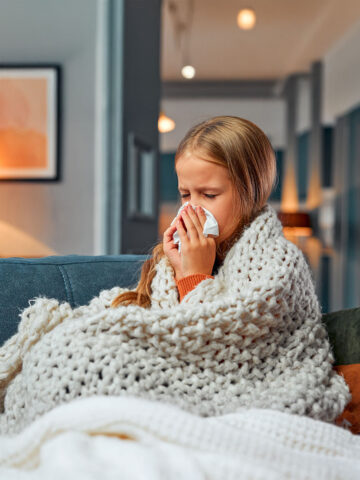If your child has an itchy sore throat, it may be a sign of a common virus like a cold or flu; or a sore throat can be a symptom of a strep throat infection.
Strep throat infections are more common in kids than adults. Strep throat infections are highly contagious and can be easily spread in large group settings like schools or daycare.
Here, CHOC experts answer common questions about strep throat and how to prevent its spread.
What is strep throat?
Strep throat is an infection caused by a type of bacteria (group A streptococcus). Strep bacteria are the most common cause of bacterial sore throats in children and teens.
Strep throat usually needs treatment with antibiotics. With the proper medical care — and plenty of rest and fluids — most kids get back to school and play within a few days.
How do kids get strep throat? Is strep throat contagious?
Strep throat is very contagious. Anybody can get it, but most cases are in school-age kids and teens. It is most common in children 5 through 15 years old. It is very rare in children younger than 3 years old.
Infections are common during the school year, with peaks in winter and early spring, when big groups of kids and teens are in close contact. So coughing, sneezing, playing with other kids and sharing items can increase the risk of spread. The bacteria is also often spread to others in the household if a family member has strep throat.
Kids with untreated strep throat are more likely to spread the infection when their symptoms are most severe, but can still infect others for up to 3 weeks.
That’s why it’s so important to teach kids to wash their hands well and often. This can lower their chances of getting contagious diseases like strep throat.
Hand washing 101 from CHOC experts
What are the signs and symptoms of strep throat? How can you tell strep throat isn’t just a sore throat?
Sore throats are typically caused by viruses. Strep throat infections are caused by the group A strep bacteria mentioned above. However, symptoms of strep throat do typically begin with a sore throat, along with:
- Fever.
- Red and swollen tonsils.
- Painful or swollen neck glands.
But not all sore throats are strep throats. Kids with sore throats caused by viruses usually clear up without medical treatment.
Kids who do have strep throat might get other symptoms within about three days, such as:
- Red and white patches in the throat.
- Trouble swallowing.
- Headache.
- Lower stomach pain.
- General discomfort, uneasiness or ill feeling.
- Loss of appetite.
- Nausea.
- Rash.
How is strep throat diagnosed?
If your child has a sore throat and other strep throat symptoms, call your doctor — there’s no need to visit the emergency room. The doctor will likely do a rapid strep test in the office, using a cotton swab to take a sample of the fluids at the back of the throat. The test only takes about 5 minutes.
If it’s positive, unfortunately, your child has strep throat. If it’s negative, the doctor will send a sample to a lab for a throat culture — the results are usually available within a few days.
Learn more about strep throat tests.
How is strep throat treated?
Doctors usually prescribe about 10 days of antibiotic medicine to treat strep throat.
Within about 24 hours after starting on antibiotics, your child probably won’t have a fever and won’t be contagious. By the second or third day, other symptoms should start to go away.
Even when kids feel better, they should take the antibiotics as prescribed. This is the best way to kill harmful bacteria. Otherwise, bacteria can stay in the throat and symptoms can come back. Completing all the antibiotics also prevents other health problems that a strep infection can cause, such as rheumatic fever (which can cause heart damage), scarlet fever, blood infections or kidney disease.
Ask a CHOC doc: Why is it important to finish an entire course of antibiotics?
How can I help my child feel better when they have strep throat?
Home care can help your child feel better while battling strep throat. Give plenty of liquids to prevent dehydration, such as water or ginger ale, especially if your child had a fever. Avoid orange juice, grapefruit juice, lemonade or other acidic beverages, which can irritate a sore throat. Warm liquids like soups, sweetened tea or hot chocolate can be soothing.
For fever and pain, your doctor may suggest an over-the-counter medicine, such as acetaminophen or ibuprofen. Follow the package directions on how much to give and when.
Talk to your doctor about when your child can return to normal activities. Most kids can go back to school when they’ve taken antibiotics for at least 24 hours and no longer have a fever.
How do I prevent the rest of my family from catching strep throat?
As your child’s antibiotics begin working, try to prevent spreading strep throat to others in your home with the following tips:
- Keep your child’s eating utensils, dishes and drinking glasses separate and wash them in hot, soapy water after each use.
- Make sure your child doesn’t share food, drinks, napkins or towels with other family members.
- Teach your child to cover all sneezes or coughs. If a tissue isn’t handy, kids should sneeze or cough into their elbow, not their hands.
- Remind everyone to wash their hands well and often.
- Give your child a new toothbrush after the antibiotic treatment starts and they’re no longer contagious.
For more health and wellness resources from the pediatric experts at CHOC, sign up for the Kids Health newsletter.
Find a CHOC Primary Care Pediatrician
From babies to teens, pediatricians from CHOC’s Primary Care Network partner with parents to offer immunizations, sick visits, sports physicals and more.





